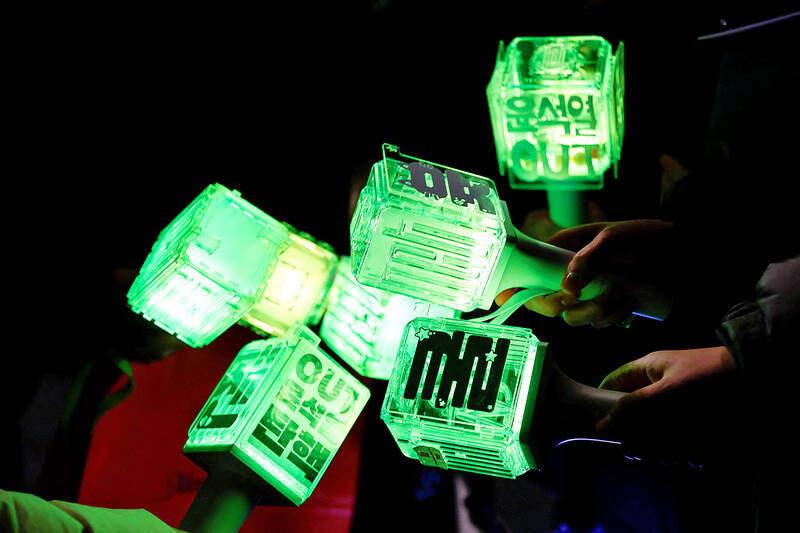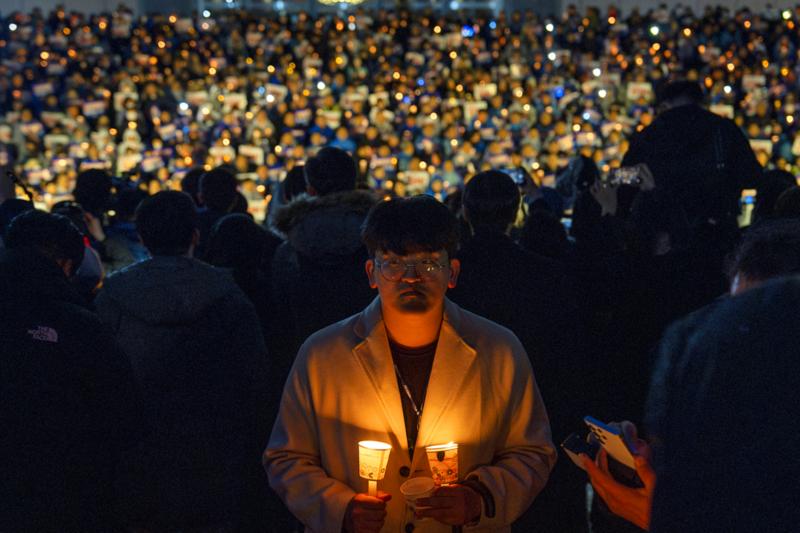While South Korean protesters have long employed songs, dances and chants, customized light sticks popular with K-pop fans have emerged as an effective new tool for demonstrators calling for the impeachment of President Yoon Suk-yeol.
Tens of thousands of protesters have braved near sub-zero temperatures and gathered outside the National Assembly in the capital of Seoul since Yoon’s failed martial law attempt last week.
“Impeach, impeach. Impeach Yoon Suk-yeol,” protesters chanted to the beat of K-pop group aespa’s latest techno track Whiplash.

Photo: Reuters
Videos of synchronized chanting and light stick movements in unison at the protests have gone viral on social media along with flags carrying messages and memes from mainly younger demonstrators.
“Give us geeks the freedom to only worry about geek things,” one meme flag carried on a flagpole at Saturday’s protest read, capturing the mood among young people amid deepening political turmoil.
One of the advantages of the light sticks is how sturdy they are, said Kim Do-heon, a Seoul-based music critic.

Photo: AP
“It also shines very bright and comes in a size that is easy to carry around.”
South Koreans are playing the long game, said Shin Jae-yun who came out to protest against Yoon with a light stick for K-pop boy band TREASURE, because protests are a “very painful act” yet there is no guarantee things will improve right away.
“To endure such pain, you have to have something to enjoy in it so that people can stay hopeful for a long time even when it drags on,” Shin said.
Playlists of popular K-pop protest songs are also being shared on X. Kim Byung-joo, a lawmaker from the main opposition Democratic Party, jumped on the trend on Monday and posted a playlist on the platform: “Impeach Yoon Suk-yeol, ringleader of treason!...from folk songs to K-pop.”
South Korea has a rich history of protest since democracy took root in the 1980s after a series of military interventions. Demonstrations over worker rights, threats from neighboring North Korea and perceived government failings have sometimes turned violent in the past.
Lee Seul-gi, a 36-year-old woman who is a fan of K-pop boyband ATEEZ, said the impeachment protests this time around have become more accessible.
“Previous rallies might have been a bit violent and scary. But the light sticks and K-pop have lowered the barrier,” Lee said.
CANDLE UPGRADE
Until 2016, candles were prominent at many protests and played a central role in the rallies that led to the impeachment of former President Park Geun-hye.
Park was ousted over a graft scandal and was later jailed over the scandal that exposed webs of corruption between political leaders and the country’s conglomerates.
“So many people were holding candles, putting paper cups over them and carrying them out so they wouldn’t go out. But now the age of the light sticks is here, not candles,” music critic Kim said.
Stephanie Choi, a researcher at the State University of New York at Buffalo, said the light sticks still reflect the “power of solidarity while maintaining the original meaning of non-violence.”
While men and women from all age groups are gathering and calling on parliament to impeach Yoon, young women are outnumbering their male peers at the protests.
Yoon vowed to abolish the gender equality ministry before taking office and was an unpopular candidate with women voters in their 20s in the 2022 presidential election.
He won office in 2022 by the slimmest margin in South Korean history but his party suffered a landslide defeat in parliamentary elections earlier this year.
The K-pop industry is notoriously apolitical and so are the lyrics of many K-pop songs playing at the impeachment protests. In South Korea, celebrities expressing political opinions are often frowned upon.
But experts say fans are conscious of K-pop’s power and the underlying messages of female empowerment it carries.
“K-pop is a female-dominant space...and their feminist demands have shaped K-pop’s aesthetics and performances today,” Choi said.
Kim Da-in, a 19-year-old fan of virtual idol group Plave, said the impeachment protests are uniting all K-pop fandoms.
“Here, I feel that we are citizens of South Korea first before we are idol fans.”

On April 26, The Lancet published a letter from two doctors at Taichung-based China Medical University Hospital (CMUH) warning that “Taiwan’s Health Care System is on the Brink of Collapse.” The authors said that “Years of policy inaction and mismanagement of resources have led to the National Health Insurance system operating under unsustainable conditions.” The pushback was immediate. Errors in the paper were quickly identified and publicized, to discredit the authors (the hospital apologized). CNA reported that CMUH said the letter described Taiwan in 2021 as having 62 nurses per 10,000 people, when the correct number was 78 nurses per 10,000

As we live longer, our risk of cognitive impairment is increasing. How can we delay the onset of symptoms? Do we have to give up every indulgence or can small changes make a difference? We asked neurologists for tips on how to keep our brains healthy for life. TAKE CARE OF YOUR HEALTH “All of the sensible things that apply to bodily health apply to brain health,” says Suzanne O’Sullivan, a consultant in neurology at the National Hospital for Neurology and Neurosurgery in London, and the author of The Age of Diagnosis. “When you’re 20, you can get away with absolute

May 5 to May 11 What started out as friction between Taiwanese students at Taichung First High School and a Japanese head cook escalated dramatically over the first two weeks of May 1927. It began on April 30 when the cook’s wife knew that lotus starch used in that night’s dinner had rat feces in it, but failed to inform staff until the meal was already prepared. The students believed that her silence was intentional, and filed a complaint. The school’s Japanese administrators sided with the cook’s family, dismissing the students as troublemakers and clamping down on their freedoms — with

As Donald Trump’s executive order in March led to the shuttering of Voice of America (VOA) — the global broadcaster whose roots date back to the fight against Nazi propaganda — he quickly attracted support from figures not used to aligning themselves with any US administration. Trump had ordered the US Agency for Global Media, the federal agency that funds VOA and other groups promoting independent journalism overseas, to be “eliminated to the maximum extent consistent with applicable law.” The decision suddenly halted programming in 49 languages to more than 425 million people. In Moscow, Margarita Simonyan, the hardline editor-in-chief of the